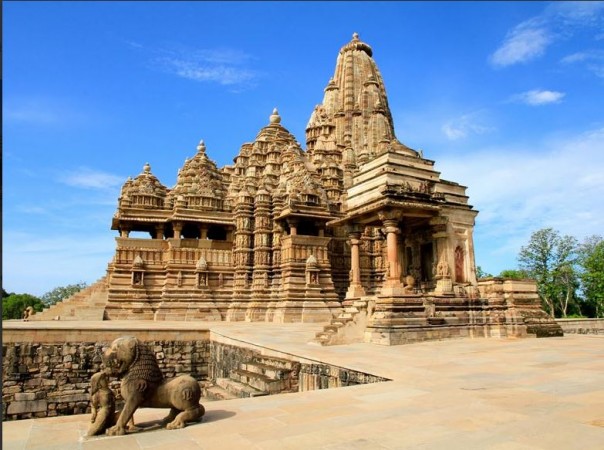
Vamana Temple is located in Khajuraho, Madhya Pradesh. This temple is dedicated to Vamana, the fifth incarnation of Lord Vishnu. This is the first incarnation where Vishnu came in a full human form, as a dwarf Brahmin. The Vamana Temple stands as a remarkable testament to the architectural brilliance of ancient India. Dedicated to the Vamana avatar of Lord Vishnu, this temple is a harmonious blend of intricate sculptural work, exquisite carvings, and spiritual symbolism, making it one of the must-visit destinations for art enthusiasts and history lovers alike.
The Vamana Temple, like most other Khajuraho temples, follows the Nagara architectural style prevalent in Northern India. It is a sandstone temple consisting of a sanctum, a mandapa (assembly hall), an ardhamandapa (anteroom), and a porch, all surrounded by a boundary wall. The temple faces east, which is a common characteristic of Hindu temples to signify the direction of the rising sun.
Also Read: Know the history of Jejuri Garh in Maharashtra
The exterior of the Vamana Temple is adorned with intricate and elaborate sculptures that depict various scenes from Hindu mythology, secular life, and celestial beings. The temple's main entrance, known as the gopuram or the towering gateway, is an intricately carved masterpiece, showcasing celestial figures, celestial nymphs (apsaras), and various other deities.
A prominent feature of Khajuraho temples is the erotic sculptures that adorn some of the outer walls. These sculptures, although a relatively small percentage of the overall artwork, have garnered much attention and curiosity over the years. The presence of such sculptures is believed to symbolize the celebration of life and the balance between spiritual and material aspects.
Also Read: Hindu Temples and Their Architectural Styles Across India
As one enters the sanctum of the Vamana Temple, they are greeted with a sense of divine presence. The inner walls of the sanctum are adorned with beautifully carved figures of gods and goddesses, depicting scenes from Hindu mythology. The main deity, Vamana, stands in a graceful threefold bending posture with one foot raised, representing his dwarf avatar.
The inner sanctum is designed in such a way that during the equinoxes, the first rays of the rising sun illuminate the idol of Vamana, creating an ethereal sight that attracts pilgrims and visitors alike.
The Vamana Temple, like many other temples of its time, was not just a place of worship but also served as a cosmic diagram representing the Hindu cosmology. The temple's layout and orientation align with the principles of Vastu Shastra, an ancient Indian architectural science that emphasizes the harmony between the physical environment and spiritual well-being.
Also Read: The Mythological Stories and Symbolism Behind Greek Temples
The architecture also incorporates sacred geometrical patterns, such as the mandala, which symbolizes the universe's microcosm and macrocosm. The temple's various sculptures and carvings carry spiritual messages, inviting devotees to contemplate the deeper meaning of life and the connection between the material and spiritual realms.
Over the centuries, the Khajuraho temples suffered from the ravages of time and various invasions. However, their remote location and the dense forest surrounding them acted as a natural defense, safeguarding them from complete destruction.
In the modern era, the Archaeological Survey of India (ASI) has been actively involved in the preservation and restoration of these temples. With extensive conservation efforts, the Vamana Temple, along with other Khajuraho temples, has been recognized as a UNESCO World Heritage Site, ensuring their protection for future generations to admire and appreciate.
Also Read: Sri Padmanabhaswamy Temple, Kerala: A Historic Abode of Spiritual Grandeur
The Vamana Temple in Khajuraho is a living testament to the rich cultural heritage and architectural prowess of ancient India. Its intricate carvings, spiritual symbolism, and historical significance make it a treasure trove of art and history. As one stands in awe of the temple's beauty and spiritual aura, it is a reminder of the artistic achievements of our ancestors and the enduring legacy of India's architectural brilliance. Whether as a place of worship, an architectural marvel, or a repository of timeless art, the Vamana Temple continues to captivate the hearts and minds of visitors from all walks of life.
Also Read: Lepakshi Veerabhadra Temple: A Glorious Chronicle of Divine Grandeur